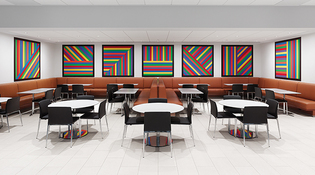 loading
loading
Arts & CultureMusic on the wallsSol LeWitt’s drawings at Yale. John Hogan, of the Yale University Art Gallery, is the Mary Jo and Ted Shen Installation Director and Archivist for Sol LeWitt Wall Drawings.  © 2019 Estate of Sol Lewitt. Photo: Christopher Gardner.The work was executed by others, but the art is by Sol LeWitt. Wall Drawing #1151 is shown here in the Ellis-Lorimer Commons at the School of Management’s Evans Hall. (From left to right: Figures E, D, G, B, F, C, and A.) View full imageThe artist Sol LeWitt often said that he created the visual equivalent of musical scores. In all, he produced 1,351 wall drawings. He didn’t draw them; he created the ideas and the forms, so that others could execute them. Once a piece of music is composed, the art exists. It is the composer’s work and art. Performance of the piece is temporal, repeatable, each with its influencing factors: the skills of the musicians, the instruments, the space in which the work is performed. Each performance is a version of the composer’s work. LeWitt felt that his work functioned in the same way. He is considered the founder of the conceptual art movement. He produced the “concept” of the work, including its ability to be repeated in various times and places (assuming that the concept was respected in execution). The creation of art, he asserted, could be distilled down to the artist’s initial idea, and the concept and its execution would become the proof or realization of that idea. In the 12 years since LeWitt’s death, countless drawings have been executed according to his instructions. He used a myriad of approaches. Among them: simple text instructions; complex, exacting plans; serial and systems thinking; theoretical visualizations of randomness and mathematical formulas; a dry bit of humor; geometry; and reliance on the basic nature of the materials used. Shown above is Wall Drawing #1151, a recent installation in the Yale School of Management. Yale has many other works of LeWitt’s on campus: at Morse College, Smilow Cancer Hospital, the West Campus, and the Yale University Art Gallery (where five are currently installed). LeWitt’s ties to the university—including friendships with students, professors, curators, and Jock Reynolds, the previous director of the Art Gallery—led to Yale’s receiving, after LeWitt’s death, the largest collection of his wall drawings in the world. A year after his passing, the Art Gallery and the Massachusetts Museum of Contemporary Art (MassMoCA) arranged for his studio assistants, working with students from across the country, to install 105 of his wall drawings in MassMoCA’s complex of factory buildings. I began working with Sol LeWitt in the early ’80s. There was an ever-expanding range of skills to be learned and ideas to be understood—unusual for an artist-assistant relationship. Assistants are generally expected to do as they’re told and act as an extension of the artist’s hand, an invisible part of the work without personal input or credit. LeWitt’s approach asked that we come to understand the content of the work to a degree equal to the skills it required. To understand the work and render it in a democratic hand that was universally human, but not specifically individual, was a delicate balance to achieve but essential to properly executing the work. It was a skill that required a deeper understanding of the intention of the work itself. It informed my own work as an artist and remains an aspect of my thinking. Each of his drawings has its own prerequisites for execution, sometimes embracing the modestly skilled nonartist’s hand, sometimes requiring highly skilled artists with years of experience and knowledge of how to use the appropriate materials. LeWitt insisted that the drafter was a collaborator, empirical proof of his concept and process, and that drafters should be credited along with him in related labels or catalogs. LeWitt created his first wall drawing in 1968, a time of cultural change and questioning of contemporary theory and cultural norms. Today, much of the reality we deal with is virtual, and the underlying concept or idea can be manufactured or experienced in a myriad of platforms or technologies. His was an artistic practice that previsioned the future.
The comment period has expired.
|
|